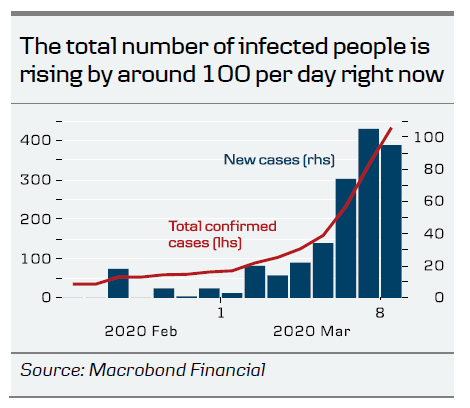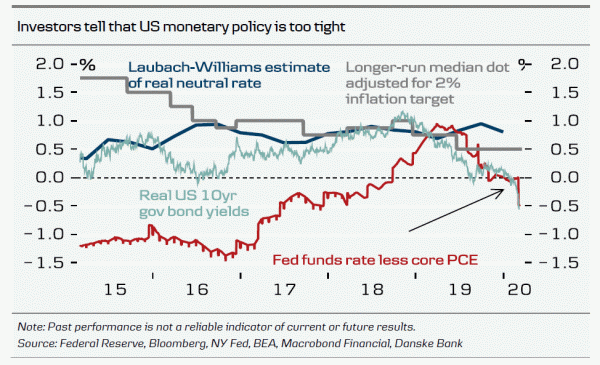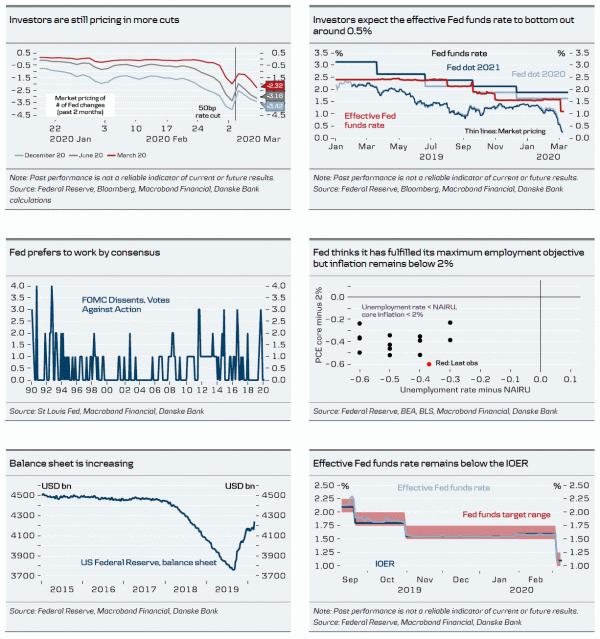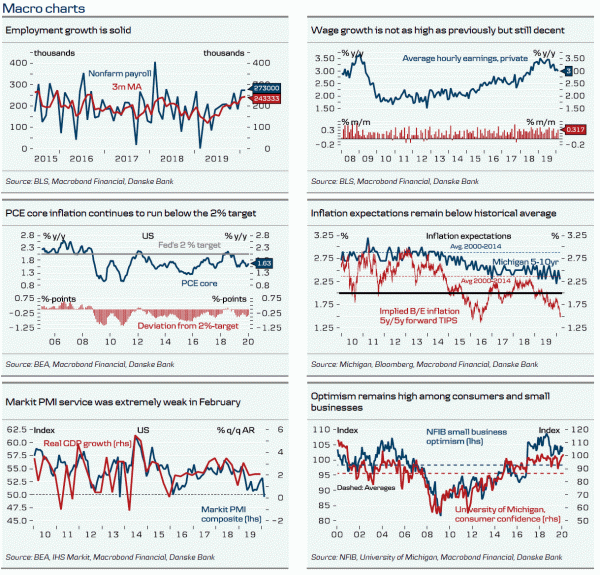Since changing our Fed call last time on 3 March calling for 50bp cuts, we have become more concerned and investors are too. Over the weekend, the number of coronavirus cases in the US has risen around 100 per day (around 450 in total). The death rate around 4% suggests more people are infected than what the official data shows. It is easy to get carried away in the current environment, but we are admittedly concerned.
The Fed will probably never admit it but it has become a slave of the market and rightly so. Investors have already priced in more than 50bp cuts at the March meeting and if it does not live up to market expectations, the reaction may be very negative, which is exactly what the Fed wanted to avoid by cutting 50bp in the first place. The Fed has not really given us much new to rely on ahead of the blackout period, which begun Saturday, and we are not sure we can rely too much on what it has been saying either. Just a couple of days before the 50bp cut even the dovish FOMC members were more or less rejecting easing. What we do know, however, is that the Fed at the Fed Listens Conference in Chicago in June learned that monetary policy is more effectual if the Fed reacts quickly and forceful. That said, Bullard said ‘everything is on the table’ and ‘we can meet anytime’ on Friday.
So basically, everything still supports further Fed action. (1) risk sentiment is still very negative despite the 50bp rate cut, (2) recession risk is still elevated, (3) we are clearly not virologists but the coronavirus situation in the US seems worse than we thought it would be, (4) monetary policy is not as accommodative as the Fed thinks (see chart on page 3), (5) inflation and inflation expectations remains below the 2% target (and the recent oil price drop means downside risks going forward) and (6) monetary policy is more effective when it is fast and forceful. Based on this, we have changed our Fed call in several ways (the monitor continues on page 2).
We now expect the Fed to cut interest rates by at least 100bp and our base case is the target range will decline all the way down to 0.00-0.25% in coming two months. We think the Fed will start by cutting 50bp in March but we would not be surprised if it happens already before the scheduled meeting. The Fed is still ruling out negative interest rates at this stage.
We expect stronger forward guidance from the Fed, probably saying something down the lines of ‘the current situation, for some time, warrants keeping the target Federal funds rate below levels the Committee views as normal in the longer run’, mimicking the language back in March 2014.
Extend T-bill purchases into Q3 and repo operations ‘at least through’ June (currently they are set to end in Q2 and April, respectively). The amount offered could also be raised to ensure enough liquidity in the system.
If necessary, the Fed will be willing to restart QE but it is not our base case yet. Fed’s Rosengren thinks the Fed should be allowed to buy a broader range of assets including stocks but QE is controversial in the US. The same goes for buying credit
Providing liquidity directly to non-banks, which is allowed under Section 13(3), should be considered as a last resort. It has only been used twice, under the Great Depression and Great Recession, so the situation needs to deteriorate significantly further from here.
We recognise that the current situation is fluid and hence that things can change quickly if facts change. There is a risk that the Fed will only hesitantly ease monetary policy and remains behind the curve. If that is the case, risk sentiment can remain sour for longer. If the coronavirus fears go away soon, the Fed can always adjust monetary policy accordingly later on. Right now it should, in our view, focus on avoiding the very negative risk sentiment to develop into a real economic crisis.


















